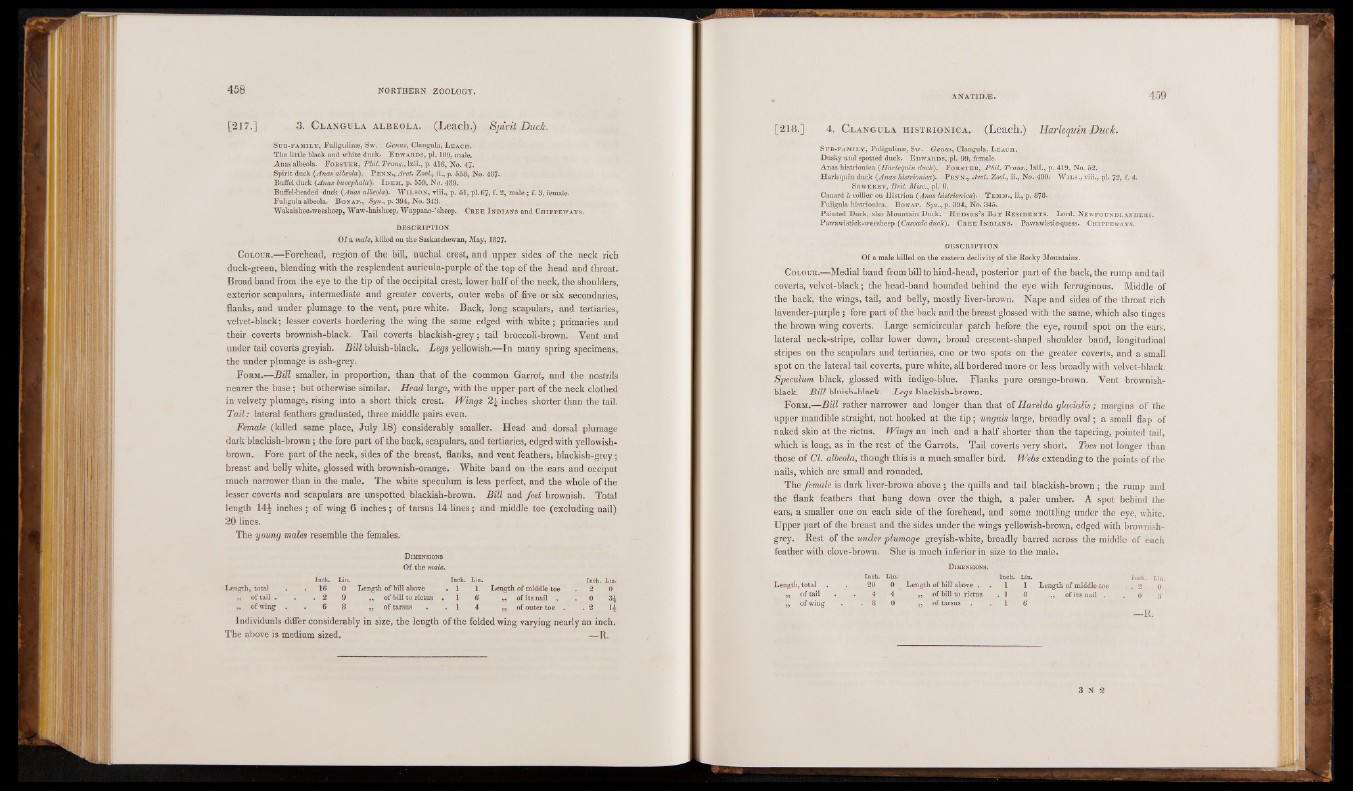
[21 7.] 3. C l a n g u l a a l b e o l a . (Leach.) Spirit Duck.
Sub-family, Fuligulinae, Sw. Genus, Clangula, Leach.
The little black and white duck. Edwards, pi. 100, male.
Anas albeola. F orster, Phil. Trans., lxii., p. 416, No. 47.
Spirit duck (Anas albeola). P enn., Arct. Zool., ii., p. 558, No. 487.
BufFel duck (Anas bucephala). I dem, p. 559, No. 489.
Buffel-headed duck (Anas albeola). Wilson, Tiii., p. 51, pi. 67, f. 2, male; f. 3, female.
Fuligula albeola. Bonaf., Syn., p. 394, No. 343.
Wakaishee-weesheep, Waw-haisheep, Wappano-’sheep. Cree I ndians and Chifpeways.
DESCRIPTION
Of a male, killed on the Saskatchewan, May, ] 827.
Colour.—Forehead, region of the bill, nuchal crest, and upper sides of the neck rich
duck-green, blending with the resplendent auricula-purple of the top of the head and throat.
Broad band from the eye to the tip of the occipital crest, lower half of the neck, the shoulders,
exterior scapularsy-intermediate and greater coverts, outer webs of five or six secondaries,
flanks, and under plumage to the vent, pure white. Back, long scapulars, and tertiaries,
velvet-black; lesser coverts bordering the wing the same edged with white; primaries and
their coverts brownish-black. Tail coverts blackish-grey; tail broccoli-brown. Vent and
under tail coverts greyish. Bill bluish-black. Legs yellowish.—In many spring specimens,
the under plumage is ash-grey.
Form.—Bill smaller, in proportion, than that of the common Garrot, and the nostrils
nearer the base; but otherwise similar. Head large, with the upper part of the neck clothed
in velvety plumage, rising into a short thick crest. Wings 2£ inches shorter than the tail.
Tail: lateral feathers graduated, three middle pairs even.
Female (killed same place, July 18) considerably smaller. Head and dorsal plumage
dark blackish-brown ; the fore part of the back, scapulars, and tertiaries, edged with yellowish-
brown. Fore part of the neck, sides of the breast, flanks, and vent feathers, blackish-grey;
breast and belly white, glossed with brownish-orange. White band on the ears and occiput
much narrower than in the male. The white speculum is less perfect, and the whole of the
lesser coverts and scapulars are unspotted blackish-brown. Bill and feet brownish. Total
length 14J inches; of wing 6 inches; of tarsus 14 lines; and middle toe (excluding nail)
20 lines.
The young males resemble the females.
Dimensions
Of the male.
Inch. Lin.
Length, total . 16 0 Length of bill above
. 1 Length of middle toe . „ of tail .' . . 9 ,, of bill to rictus 1 . 1 6 „ of its nail . 2 . 0 „ of wing 2 . 6 8 „ of tarsus . 1 4 ,, of outer toe . . 0 H 2 1
Individuals differ considerably in size, the length of the folded wing varying nearly an inch.
The above is medium sized. —R.
[218.] 4. C l a n g u l a h is t r io n ic a . (Leach.) Harlequin Duck.
Sub-family, Fuligulinae, Sw. Genus, Clangula, Leach.
Dusky and spotted duck. Edwards, pi. 99, female.
Anas histrionica (Harlequin duchy., .Forster, Phil. Trans., lxii., p. 419, No. 52.
Harlequin duck (Anas histrionica). Penn., Arct. Zool., ii., No. 490. W il s ., viii., pi. 72, f. 4.
Sowerby, Brit. Misc., pi. 6.
Canard a collier ou Histrion (Anas histrionica). Temm., ii., p. 878.
Fuligula histrionica. Bonap. Syn., p. 394, No. 345.
Painted Duck, also Mountain Duck. Hudson’s Bay Residents. Lord. Newfoundlanders.
Pawawistick-weesheep (Cascade duck). Cree I ndians. Pawawistic-quess. Chippeways.
DESCRIPTION
Of a male killed on the eastern declivity of the Rocky Mountains.
Colour.—Medial band from bill to hind-head, posterior part of the back, the rump and tail
coverts, velvet-black; the head-band bounded behind the eye with ferruginous. Middle of
the back, the wings, tail, and belly, mostly liver-brown. Nape and sides of the throat rich
lavender-purple; fore part of the back and the breast glossed with the same, which also tinges
the brown wing coverts. Large semicircular patch before the eye, round spot on the ears,
lateral neck-stripe, collar lower down, broad crescent-shaped shoulder band, longitudinal
stripes on the scapulars and tertiaries, one or two spots on the greater coverts, and a small
spot on the lateral tail coverts, pure white, all bordered more or less broadly with velvet-black.
Speculum black, glossed with indigo-blue. Flanks pure orange-brown. Vent brownish-
black. Bill bluish-black. Legs blackish-brown.
Form.—Bill rather narrower and longer than that of Harelda glacialis ; margins of the
upper mandible straight, not hooked at the tip; unguis large, broadly oval; a small flap of
naked skin at the rictus. Wings an inch and a half shorter than the tapering, pointed tail,
which is long, as in the rest of the Garrots. Tail coverts very short. Toes not longer than
those of Cl. albeola, though this is a much smaller bird. Webs extending to the points of the
nails, which are small and rounded.
The female is dark liver-brown above; the quills and tail blackish-brown ; the rump and
the flank feathers that hang down over the thigh, a paler umber. A spot behind the
ears, a smaller one on each side of the forehead, and some mottling under the eye, white.
Upper part of the breast and the sides under the wings yellowish-brown, edged with brownish-
grey. Rest of the under plumage greyish-white, broadly barred across the middle of each
feather with clove-brown. She is much inferior in size to the male.
Dimensions.
Length, total .
Inch.
. 20 0 Length of bill above . Inch. Lin.
1 1 Length of middle toe Inch. Lin.
,, of tail . . 4 4 ,, of bill to. rictus . 2 0 . ,, of wing . . 1 8 •„ of its nail . . 0 3 8 0 „ of tarsus 1 6 —R.
3 N 2